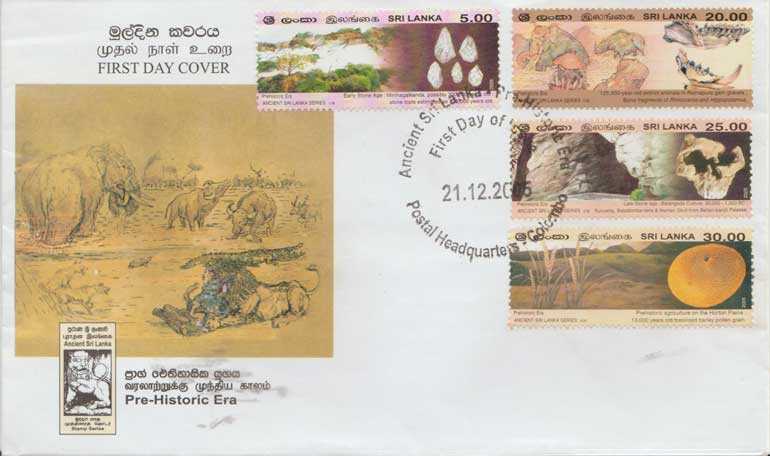Friday Jan 02, 2026
Friday Jan 02, 2026
Saturday, 19 March 2016 00:00 - - {{hitsCtrl.values.hits}}
 The release of a series of stamps by the Philatelic Bureau on Ancient Sri Lanka has helped us to gather information of the early days of man in the country. The series opened with the issue of four stamps featuring the Pre-Historic Era.
The release of a series of stamps by the Philatelic Bureau on Ancient Sri Lanka has helped us to gather information of the early days of man in the country. The series opened with the issue of four stamps featuring the Pre-Historic Era.
Archaeologists have divided this period into three divisions on the basis of archaeological findings including physical remnants (bones and the like) and tools and other implements. The divisions are:
i) Palaeolithic – the age of the most ancient/primitive man; ii) Mesolithic – the age of the modern man, and iii) Neolithic – the period when man engaged himself in agriculture and started using metal.
Palaeolithic Age being the longest era is further divided into three: Lower/Middle/Upper.
i) Lower Palaeolithic: A few stone implements of this era have been found. Dr Shiran Deraniyagala has identified these as belonging to an era beyond 125,000 years judging by the earth deposits where these were unearthed. The very rough and coarse implements are believed to have been used by the Homo habilis man – the most ancient representative of the human genus, Homo. There is no clear picture of the activities and history of this species.
ii) Middle Palaeolithic: Evidence of this era has emerged from coastal areas, around Ratnapura, Galkanda, Ussangaoda and Buttala in the Hambantota District, and Iranamadu in the North. Implements found in these areas had been used by the extinct species Homo erectus – meaning ‘upright man’.
iii) Upper Palaeolithic: A rather hazy era due to the non-availability of source material.
Mesolithic Age
The period dates back 40,000 years and beyond when small size stone tools had been in usage. It was the era of the Homo Sepeanne Seoumane, the present day man. These people had been well spread throughout the country.
Among the caves they had occupied were the Batadomba-lena (Kuruvita), Kitulgala Beli-lena, Pahiyangala cave, Maniyamagama Beli-lena at Esmadalagama, Avissawella – all in the wet zone; Sigiriya and Potana caves in the dry zone; and fossil deposits in coastal zones like Pallemalla.
Neolithic Age
While opinions differ about this era, the evidence is also sparse. Some information has been received from excavations at Dotawaka Kanda. However, recent research has shown that people in Sri Lanka had been used to agricultural activities for the past nearly 13,000 years.
Pre-historic stamps
Early habitat area at Minihagalakanda in the south coast and stone tools are featured in the Rs 5 stamp. The area situated at the Southern coastline adjoining the Panama region, represents the period between Plasotosino and Paleolithic ages. It is possibly the first habitat that has remained for 300,000 years.
The stone tools found in the area are believed to have belonged to the Middle Paleolithic Age some 125,000 years ago. The tools made from the type of stone known as ‘tirivana’, using a simple technology. These seem to have been used for hunting animals and processing their meat.
Extinct animals (Rs. 20) featured have been located from the gem mining areas in Ratnapura. One time Director of the National Museum, Dr. P.E.P. Deraniyagla has identified these single horn animals like thee hippopotamus, rhinoceros, unicorn and an elephant variety which are now extinct. The collection of bones on the right is that of a unicorn.
Batadomba-lena and human skull of the Balangoda man (Rs. 25): This cave is deemed to have been the habitat of pre-historic age. Several collections of bones and skulls have been unearthed during the excavations. They are believed to be over 7,000 years old.
Pre-historic agricultural activity in Horton Plains and barley pollen grain (Rs 30): Horton Plains had been a prominent agricultural centre of the New Paleolithic Age some 13,000 years ago. Farmers had grown and other similar crops. (The grain seen in the stamp has been enlarged 3,000 times).
Next: Early Anuradhapura Era.